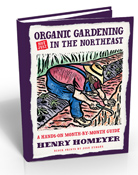Weather Worries – Not to Worry!
It seems as if the weather is getting more extreme: tornadoes, floods, drought, heat waves, cold spells. What≠s a gardener to do? Well, stop worrying, for starters. Each year the weather is different – and most years we still have nice flowers, and eventually have the lettuce and tomato for a good sandwich. And unless you≠re a commercial farmer, your life and livelihood will not be too adversely affected, even if the weather is bad. There are a few steps we can take to help our flowers and vegetables along, however.
Planting anything is best done on a cool, cloudy day – or even in a light sprinkle. If we’ve had a few days of rain, it≠s better to wait for the soil to dry out a little before planting. Rototilling wet soil is definitely a no-no, and walking on wet soil can compact it, ruining soil structure.
Adding compost, or aged cow manure, will help any soil. If you have sandy soil, it will act as a sponge to hold moisture from percolating right through. If you have a clay soil, it will improve drainage and make the soil lighter and fluffier – and more receptive to roots. Avoid fresh cow or horse manure as it will introduce grass and weed seeds to your soil – those animals don’t digest all the seeds.

tomatoes
I planted my tomatoes on a warm dry day in early June, and we almost immediately got hit by a spell of days in the 90’s. I had grown these babies from seed, and hardened them off outside, but a big, leafy tomato can lose a lot of water in the hot sun when it’s 94. So I created some shade for my tomatoes by draping row cover over the tomato cages. It helped.
Row cover is a spun synthetic fabric that is used to keep insects off plants while allowing water vapor and sunshine to pass through. It also can keep a plant a few degrees warmer early or late in the season if draped right over it. Row cover comes in various weights, and I had some of the heaviest type. It did a good job of shading my plants when placed the cages (and kept in place with clothes pins). I also kept the soil well watered during the heat wave.
A few words about watering: I don’t like overhead sprinklers. Yes, they are easy to turn on and let the machine do the work. But they get the leaves of your plants wet, and that can encourage fungal diseases. Most fungi send out hyphae (root-like appendages) that pierce the leaf, allowing the fungus to infect the plant. Many need a moist leaf surface to do that. Watering in the evening with an overhead sprinkler moistens the leaves and makes them more susceptible.

Watering Wand
I like watering with a watering wand. This is a nice 30-inch long metal handle with a watering rose on one end and a shut-off on the other. The brand I like best is Dramm. It sends out a nice gentle spray, even with the water pressure up fairly high. I find the less expensive watering devices send sharp sprays, which can damage the plants or wash away the soil. I like the watering wand because I can deliver water to the root zone while letting the tops stay dry.
Newly planted trees and shrubs need to be watered weekly, or even more often if the soil is sandy and temperatures are high. The most common cause of first-year death of trees is dehydration. But don≠t just give your new tree a quick squirt. Time how long it takes for your hose to deliver 5 gallons of water into a bucket, and then make sure to spray long enough to deliver 5 gallons – in a nice wide circle around the tree. Watering the rootball is not enough √ dry soil nearby will wick the water away, leaving the rootball dry in no time.
Many gardeners put down bark mulch in established perennial beds. This keeps down the weeds and holds in moisture. But if you add more mulch each year to pretty-up the beds, you can develop a layer of bark that is almost impermeable to rain. I find an inch to an inch-and-a-half of mulch is adequate. And I try to leave a little donut hole around the plant so that quick showers can deliver some water to the roots.
Recently I examined some maples that were dying in a parking lot √ the top half of one was completely leafless, the others also showed some leaf loss. These trees were suffering from bark rot due to ≥mulch volcanoes≈. Each had at least 6 inches of bark mulch right up against the trunk. I predict that all will be dead from bark rot within 2-3 years. And all will struggle getting any moisture. So be judicious in applying your mulch.
If we have another week of rainy weather, your vegetables like tomatoes may show yellowing leaves – a sign of stress. This occurs because normally plants pull up nitrogen and other minerals from the soil with water that is used to replace water lost to transpiration on sunny days – but not in rainy spells. The solution: spray liquid fish fertilizer onto the leaves. The leaves will absorb the nitrogen and green up.
So don’t worry, be happy. No matter what the weather, your garden will (eventually) be just fine.


